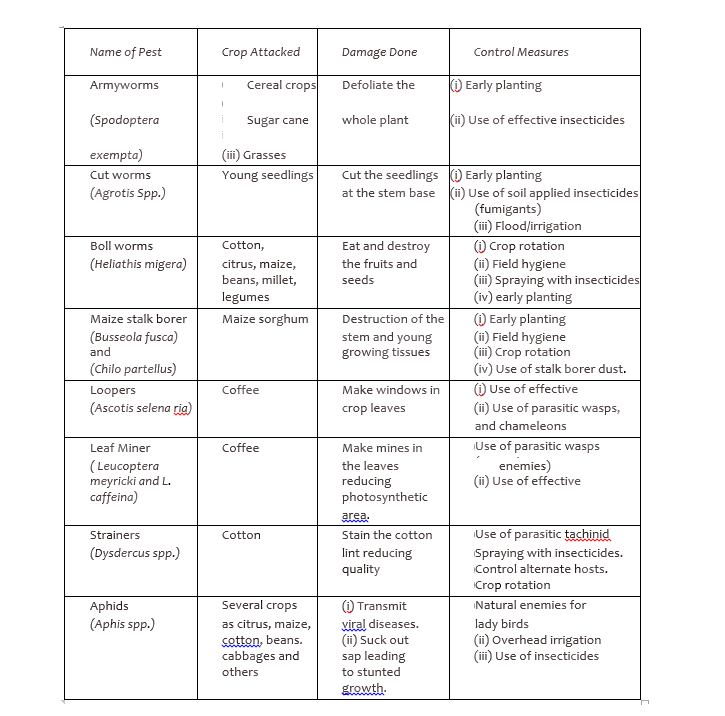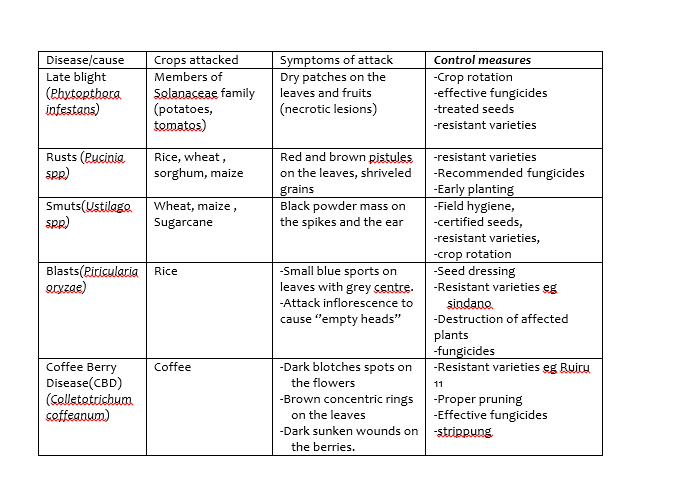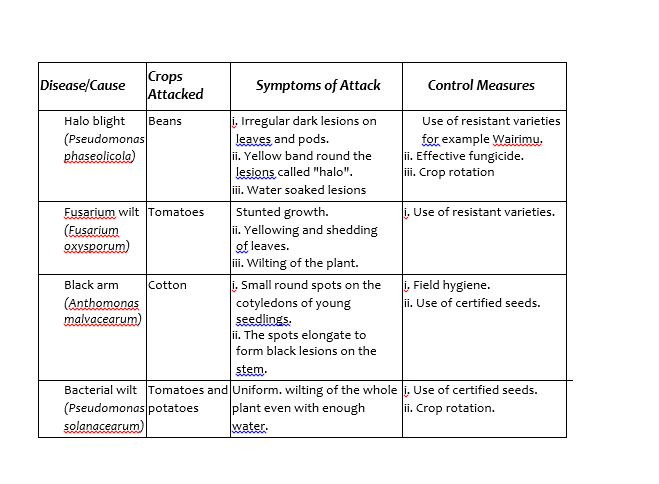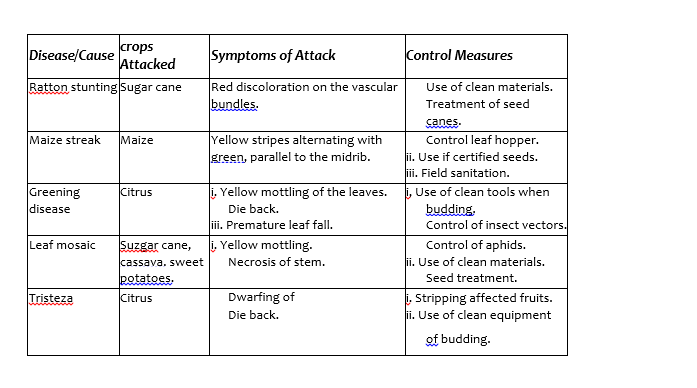Introduction
- Crop pests and diseases lead to high losses in crop production hence efficient control measures are
- Proper control measures require the farmers to be able to;
- Identify these organisms,
- Know their life cycles, feeding habits
- The damage they cause to crops.
Crop Pests
Definition of a Pest:
- It is a living organism that destroys crops/ trees either directly or indirectly by introducing pathogens (disease causing germs).
Classification of Pests
Pests are classified according to the following:
Mode of Feeding
- Pests with biting and chewing mouth parts – they cause physical damage and reduce the photosynthetic area of the plant.
- Pests with piercing and sucking mouth parts – they suck out the nutritious plant sap and in the process may introduce disease causing organisms.
Crops Attacked
- Some crop pests attack specific crops for example, stem borers prefer cereal crops.
Stage of Growth of Crops Attacked
- There are pests of seedlings attack when the crop is young, for example cutworms.
- Pests of fruits – attack the crops at fruiting stage.
- Pests of grains attack the crops when the grains are formed.
Field and Storage Pests
- Some pests attack the crops while in the farm
- Other pests attack the produce after it has been harvested and stored.
Identification of Common Pests

Other Crop Pests Include:
- Mealy bugs – coffee
- Thrips – coffee
- Beetles – field and storage pests.
- Birds – field pests – cereals and fru
- Rodents – field and storage pests ,cereals and t
- Nematodes – soil borne pests – tomatoes, potatoes, sunflower, beans.
Harmful Effects of Crop Pests
- Pests such as squirrels and rodents, unearth planted seeds, resulting in poor
- Some pests like nematodes, termites and moles damage crop roots causing wilting and death of the crops.
- They lower the quality and quantity of farm produce.
- They increase the cost of production since farmers will incur expenses in purchasing chemicals to control them.
- They transmit diseases to crops for example, aphids transmit streak virus disease in maize.
- Chemicals used to control the pests cause pollution to the environment.
- They exterminate the crop by feeding on them for example eating embryo of the seed.
Control of Pests
- If pest population causes damage beyond tolerance then it is said to have reached economic injury level (EIL) hence control measures should be effected before this level.
Before any control measure is effected ,the following should be considered:
- Know the life cycle of the pest.
- Correct identification of the pest.
- Correct assessment of the damage.
- The weather conditions.
- The value of the crop in question.
- The cost factor of the control method.
Methods of Controlling the Pests
- Cultural methods.
- Physical/mechanical measures
- Biological methods.
- Chemical methods.
- Integrated pest management.
Cultural Methods:
- These are farming practices which aim at reducing the pest population by destroying the life cycle of the pests either by exposing them to adverse conditions or denying them food.
These include:
- Timely planting to escape pest attack.
- Timely harvesting.
- Proper tillage.
- Close season: this is the period when a susceptible crop is not grown in order to control a certain pest.
- Trap cropping: These are crops which attract pests diverting them from the main crop. The trap crop is grown together with the main crop.
- Crop rotation: It breaks the life cycle of the pest.
- Planting resistant varieties: These are plants with natural protective mechanisms against pest for example hairy cotton against jassid bugs, goose necked sorghum against birds, high tillering in sorghum against shoot fly.
- Field hygiene: This includes rogueing and removal of crop residues which harbour pests from field.
- Alterations of environmental conditions, such as, creating a microclimate which is not conducive to pests for example open pruning in coffee.
- Crop nutrition: application of fertilizers and manures to make the crop strong and able to escape pest attacks.
- Destruction of alternate hosts, for example, weeds like mallow which harbour cotton stainers.
- Use of clean planting materials. This helps to prevent introduction of crop pests.
- Proper spacing: if well spaced some pests find it difficult to move from one plant to another.
- Use of organic manure, for example, farmyard manure discourages eel worms (nematodes).
Chemical Control
- Chemicals used to control pests are known as pesticides.
- Pesticides are administered through dusting, spraying or fumigating.
Classification of Pesticides:
Pesticides are classified on the basis of:
Mode of Entry
- Stomach – ingested by the pest together with the crop materials.
- Contact – absorbed through the body tissues.
- Fumigants – through the breathing mechanism.
- Systemic – translocated to all parts.
Mode of Action
- Respiratory poisons – interfere with breathing mechanisms.
- Coagulants – cause the blood of the pest to coagulate.
- Neurotoxins – act on the nervous system.
- Protoplasmic poisons – cause the cells to disintegrate.
Target Pests
- Insecticides – kill insect pests
- Molluscicides – kill snails and slugs.
- Rodenticides – kill rodents.
- Nematicides – kill nematodes.
Formulation .
- Dusts, granules and powders
- Emulsifiable concentrates.
- Miscible liquids.
- Wettable powders.
- Fumigants.
Factors That Affect the Efficiency of Pesticides
- Concentration of the pesticides.
- Weather conditions at the time of application.
- Timing of application – efficiency is high if applied when the pest is most susceptible.
- Persistence of the pesticide having long residual effect in the soil.
- Resistance of the pests.
Advantages of Chemical Pest Control
- Faster
- Immediate results are achieved.
- Low labour requirements.
Disadvantages of Chemical Pest Control
- Expensive to buy.
- Cause pollution to the environment.
- Require skilled labour to apply.
- Some pesticides may kill beneficial organisms and predators.
- Some target pests may build up resistance.
Mechanical Pest Control/Physical
- This involves the killing of the pests using physical methods.
- Or creating physical barriers to prevent pests from getting into contact with the crops .
Example:
- Flooding/irrigation; for example, moles are suffocated through flooding.
- Use of lethal temperatures: either too cold or too hot.
- Suffocation; commonly used in grain storage bins by being made air tight.
- Trapping and killing, for example, rats.
- Creation of physical barriers, such as, rat bafflers, sticky materials on tree trunks.
- Proper drying: this makes them too hard to be destroyed by pests.
- Scaring devices especially in rice plantations to control birds.
- Use of explosives thrown at breeding places of birds to kill or scare them away.
Biological Pest Control
- It involves the use of living organisms to reduce the pest population.
Predator Target Pest
- Parasitic wasp——————-White fly in citrus, boll worms, stalk borers
- Birds——————————— Crickets, locusts, caterpillar llars.
- Lady Bird ————————–Aphids
- Trachnid flies ——————-cotton stainer
- Praying mantis—————–giant loppers
- Majimoto ants —————–scales
- Cats ———————————-moles,rats,mice
- Brachonid wasps————-mealy bugs
- Chicken —————cotton stainer, larvae of beetles, grasshoppers, crickets
Advantages
- Cheap
- No environmental pollution
- Saves on labour.
Disadvantages
- Takes too long to get the correct agent
- Difficult to control the pest effectively.
Integrated Pest Management
- It is a new method which involves the combination of the methods mentioned above.
- The aim is to have least hazards to the user and to the environment.
- Example, attractant-pheromones are used to attract pests to one place where they are sprayed and eradicated.
Legislative Method/Quarantine
- Legislative mearsures of pest control are effected by the Kenya Plant Health Inspectorate Service(KEPHIS) through seed inspection.
Crop Disease And Their Control
- A disease is any deviation from the normal performance or functions.
- A plant disease is any harmful physiological disorder in a plant caused by pathogenic agents such as virus, bacteria, fungi.
- The study of plant disease is called plant pathology.
Economic importance of crop diseases
- They lower crop yield
- They reduce the quality of the produce thus reducing their market value
- They cause food poisoning. E.g ergot in wheat, afflatoxin in grain crops by fungus.
- They reduce photosynthetic area of the plant.
Classification and identification of plant disease
- Plant disease are classified according to their causal agents;
Fungal diseases;
- Fungi are non-green plant-like.
- Some are parasitic and others are saprophytic.
Parasitic fungi divided into;
- Obligate parasites- those that depend on other living organisms for food.
- Falcultative parasites-those that are able to live on both the living and dead tissues.
Examples of fungal disease
- Panama disease(Fusarium oxysperium—bananas)
- Cigar-end rot(Verticilium theobromae)-bananas
- Die back –attack the tips of shoots and roots
- Mildews-foliar disease of several crops
- Armillaria root rot(Armillaria mellea)-coffee and tea
- Damping off-disease of seedlings in the nursery
- Anthracnose (Colletotrichum spp)-coffee,beans,tomatoes.
- Fungus also cause damage to stored grains which are not properly dried or if the store is damp.
- Fungus cause food poisoning and lower seed viability for example Aspergillus flavus which produces a highly toxic compound called afflatoxin.
Examples of fungal disease

Bacterial Diseases
- Bacteria are microscopic single-celled organisms which reproduce by binary fission
- Transmission; Through irrigation water, seeds, fertilizers, manures, wind ,
- raindrop splash, insects, soil and mechanical means.
Symptoms of Bacterial Diseases
- Wilting
- Cankers(necrotic tissues)localized necrosis
- Gall formation in infected tissues.
Examples of bacterial diseases

Viral Diseases
- Viruses are small living organisms which can only be seen under a very powerful electronic microscope.
- Viruses interfere with photosynthesis, respiration, transpiration and nitrogen utilization
Symptoms of Viral Infection
- Leaf chlorosis.
- Leaf curling.
- Mosaic(light green or yellow patches).
- Malformation(distortion)of plant parts.
- Rosettes; Development of abnormally short internode.
Transmission
- Through the use of infected vegetative materials and insect vectors like aphids, mealybugs and leafhoppers.
Viral diseases

Other Causes of Crop Diseases
- Flooding forming ammonia which is poisonous to the crops causing a burning effect on leaves.
- Chemicals: some may be toxic.
- Poor weather: Extremes of day and night temperatures.
- Stress: such as irregular watering as in tomato blossom end rot.
Control of Crop Diseases
- Cultural method: This involves use of
- Healthy planting materials.
- Practicing field hygiene.
- Proper seedbed preparation.
- Proper spacing.
- Heat treatment of the planting materials for example sugar cane.
- Proper drying of cereals and pulses to 13%M.C.
- Growing disease resistant varieties.
Legislative Method
- Involves the imposing of regulations and laws especially in case of disease outbreaks to prevent the introduction and spread of diseases.
Chemical Control
- Used as a last resort.
Chemical control measures include:
- Seed dressing before planting.
- Soil fumigation to control soil borne diseases.
- Spraying: application of fungicides.
